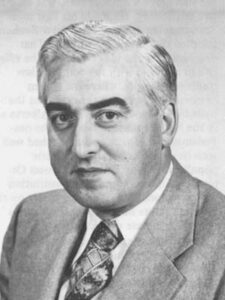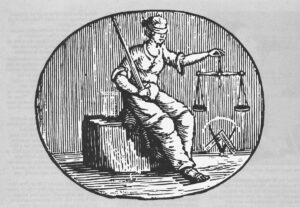
(EDMONTON, ALBERTA) – From his sixteenth-floor office, Randall Ivany can look out over the rolling sweep of the Alberta prairie, punctuated by the silhouettes of wooden grain elevators and the stainless-steel gleam of oil refineries – the old and new sources of the province’s wealth. The commanding view inspires a sense of unbounded power, but, paradoxically, Randall Ivany’s job is to combat precisely that attitude among the officials who govern this prosperous western domain. He is there to ensure that they do not forget humility, fairness and what he likes to call “natural justice.”
Ivany is the very model of the modern ombudsman, the arch-foe of overweening bureaucracy. He is the second incumbent of Alberta’s Office of the Ombudsman, a pioneering effort to transplant that Scandinavian invention to North America. The transplant has taken firm root. The office has functioned smoothly for more than 13 years, has answered thousands of citizen grievances and has become an exemplar for governments elsewhere. All but one of the nine other Canadian provinces have followed in Alberta’s footsteps, as have four American states and a number of foreign countries.
Edmonton, moreover, has become a de facto capital of what its proponents throughout the world now confidently refer to as “the ombudsman movement.” A research arm, the International Ombudsman Institute, has been installed just across the North Saskatchewan River from Ivany’s office, at the University of Alberta. Ivany directs the institute and has chaired the International Ombudsman Steering Committee, the movement’s high command.

Thanks to the good works as well as the proselytizing of Ivany and his colleagues, the cause has begun to gather momentum. It was a sleeper, to say the least. The first ombudsman – the word means “commissioner” – took office in Sweden in the early 19th Century, but the concept slumbered on as a Nordic curiosity for 150 years. Recently though, the search for more responsive, more open government has made reformers elsewhere take a second look at this antique yet somehow fresh notion.
Ivany, a buoyant, pipe-smoking former clergyman, makes a simple case for an ombudsman: “Bureaucracy is on the increase all over the world, and there are bound to be mistakes. The ombudsman stands as a warning beacon to the civil servant that his decisions had better be good ones. Otherwise, people wouldn’t get any sort of natural justice.”
For many routine cases, the ombudsman needs only to sever the Gordian knot of red tape – unfreezing a pension check, locating a misfiled application or having a long overdue license disgorged. But he also plays a broader role as the superego of the civil service, charged with ferreting out administrative abuse. The Ombudsman Act confers a roving mandate to try to rectify that which is “unreasonable, unjust, oppressive” or simply “wrong.”
The act, however, accords him no enforcement power. As an appointee (now in his second five-year term) of the legislature, rather than a member of the executive branch, the ombudsman can merely investigate and recommend corrective steps. Ivany and his staff, therefore, rely on a principle akin to jujitsu; the very lack of strength, they believe, is a source of strength. The ombudsman makes right prevail not by force but by sheer moral authority, by persuading those who do have power that he is correct and they are in error. As Paul Wood, Ivany’s executive assistant puts it, “The genius of the concept is that ultimately we can only recommend. We not only have to be right, we have to be convincing. It’s not just a matter of substituting our decision for someone else’s.”
The ombudsman’s approach is well-illustrated by his condemnation of provincial officials for using heavy-handed tactics in 1979 against a minority group known as the “metis.” Descendants of intermarriage between white settlers and Indians, the metis lack the status and benefits of “treaty Indians,” who enjoy federal protection, yet they remain socially apart from non-Indians. Metis organizations were engaged in a legal battle against the province, which, like so much else in Alberta, involved oil revenues. To preserve them as evidence in the suit, the Department of Social Services seized the files kept at the headquarters of government-sponsored metis colonies in the north of the province. Although Ivany concedes that “legally we could get into a great harangue about whether the files belonged to the metis or the government,” he concluded in his report on the incident that “In a moral sense, the Department was removing files that at least morally belonged to Metis Settlement Associations.” That meant, he wrote, that “it was wrong, within the meaning of the Ombudsman Act.”
In such cases, the ombudsman’s ability to hold government to a broad ethical standard of conduct, Ivany argues, makes the ombudsman a better forum than the courts for vindicating individual rights. “A court’s standards of review are quite limited,” he says, “and they will accept only certain kinds of evidence. The ombudsman will look at all the evidence – relevant or not.” The cost is also quite competitive: the ombudsman’s remedy may be had for the price of a postage stamp. “You don’t go into court with a $500 complaint that will cost $1,500 to get heard,” Ivany observes.
In contrast to constricted courtroom proceedings, Ivany takes an expansive approach to his task: “I try to give the benefit of the doubt to the complainant. The government can take good care of itself. I’m not overly cautious, and neither was my predecessor (a former head of the Royal Canadian Mounted Police). We tend to proceed unless there’s a really good reason not to. We have rarely been challenged.”
One of those rare occasions, was his recommendation that a few hundred dollars be paid to each of two complainants whom he felt had been wrongfully detained by the police. The province’s attorney general objected that the Ombudsman Act did not provide for cash awards. Ivany took his case to the Lieutenant Governor in Council (the provincial cabinet), and he was upheld, setting an important precedent. “We felt,” says Ivany, “that the complainants had been deprived of liberty and embarrassed and that the equalizer was a sum of money. The attorney general didn’t have any alternatives, other than to say, ‘Sorry you had to spend this time in jail, and I hope it won’t happen again’.”
A similarly creative remedy was devised for what is known in the office as the “The Case of the Missing Moose.” A moose carcass was confiscated from a hunter who had allegedly violated the game regulations. The ombudsman decided that the hunter had been treated unfairly, but in the meantime, the evidence had disappeared from the freezer where it had been kept in custody. The ombudsman told officials to go out and shoot another moose for the aggrieved citizen.
Such custom-tailored solutions, Ivany maintains, demonstrate that an ombudsman is not only more flexible than a court in dealing with citizens’ complaints but also better able to give satisfaction than a legislator, even one devoted to constituency service. Legislators sometimes fear that ombudsmen will usurp their role as problem-solvers for the voters, but in Alberta they seem to have greeted the new office as a boon. A legislator now may respond to a difficult request by notifying the constituent that he is taking immediate action: forwarding it to the ombudsman. In contrast to the often-tedious legislative pace, Ivany says, “We don’t have to wait three years to issue a report. We can do it in three weeks. In addition, the legislators do not have access to the files. I do.” Indeed, Ivany has the authority to rummage through bureaucratic cupboards, including the right to inspect internal memoranda. He rarely needs to resort to his formal subpoena power: “I wouldn’t say that officials are ecstatic about making files available, but we are not blocked. Occasionally files have been tampered with. We simply ask for the documents that are not there that used to be there.”
Although he must press his recommendations firmly at times, Ivany insists that “confrontation is not the hallmark of our dealings with government.” He approvingly quotes Oliver Dixon, an Australian counterpart, who maintains that an ombudsman should not “regard himself as one of God’s avenging angels. It is not his province to set out to smite the establishment hip and thigh in an attempt to bring it into disarray.” Indeed, as in the Metis incident, Ivany often concludes that maladministration is prompted not by “malicious intent” but by misunderstanding – what he calls “communication breakdown.” As often as not, however, the breakdown is attributable to “quaint bureaucratic phrases” which leave the citizen puzzled. On occasion, he will single out choice specimens of garbled official missives; a recent annual report reprinted a six-paragraph letter so murky that the recipient could not understand its good news: he had won.
From time to time, Ivany encounters the quintessential snafu. In one case, an application was not being processed because it was incomplete. However, the applicant could not find out why the application was languishing because he lacked the file number, and file numbers were never assigned to incomplete applications.
In breaking through such impasses, Ivany follows a simple, threefold rule: “tact, persuasion and patience.” The persuasion begins at the lowest echelons. Rarely is it necessary to take the matter as high as the cabinet minister for the department, and only once during his tenure has Ivany had to deploy his ultimate weapon: a full-dress report to the legislature. “Generally,” says assistant Wood, “you get some degree of satisfaction for every valid complaint. The officials either see it our way or they get tired of hearing from us.”
Much of the time, Ivany depends on informal diplomacy. “What’s written on paper is one thing,” he says, “and what goes on behind the scenes is another. A good deal of it is just between me and the official.”
The ombudsman’s office has begun some investigations on its own initiative, and it has responded to more than 11,000 written complaints since 1967. Telephoners – “Do you have a problem?” the receptionist asks solicitously – are told how to put their grievances on paper. Many persons complain about landlords, merchants, lawyers, or airlines, but such private disputes are outside the ombudsman’s jurisdiction. So are grievances against municipal governments or federal agencies like the post office.
Of the 4,000 complaints that were investigated, the largest number were against the province’s social service agencies, the workers’ compensation board, the correctional authorities and the attorney general’s office, which oversees the criminal justice system. (The phone company in much of the province is government-owned, making it fair game.) About 25 to 35 percent of the investigated complaints are found to be justified. In the others, the government action is deemed proper. Roughly the same ration prevails in ombudsman offices throughout the world.
An ombudsman office itself may fall victim to bureaucratization, but in Alberta this creeping menace seems to have been staved off. There is a staff of 18, seven of whom are investigators. Although the investigators – who include former police and parole officers – gather the initial information, the opening and closing of every file is personally approved by Ivany. The ombudsman’s is also a personal office in another way: he is among the few influential figures in government with whom it is still relatively easy to get an appointment. “A minister with a thousand employees can’t see people,” Ivany says, “but I can, and I will. In a day of impersonal government, that’s important.”
People take advantage of the open-door policy. Accident victims limp in to show off their swollen knees, and a grateful woman whom the ombudsman helped to secure adoption papers brought the baby by to show how well his efforts had worked. Ivany even makes house calls of a sort. In the Metis case, he rented four-wheel drive trucks to visit their settlements, on unpaved roads in remote sections. If a complainant is unable to write, he will sometimes dispatch a staff member to help compose the formal complaint.
Ivany came to the post along a rather unorthodox route. Many ombudsmen are lawyers, but Ivany, a native of Newfoundland, was an electrical engineer who switched in mid-career to the church. He had been Anglican Dean of the Edmonton Cathedral for six years when a newspaper ad appeared, inviting applications for ombudsman. “It was something new,” he recalls, “it presented a challenge, and I was ready for a change.” He found the ministry good preparation for his new role. “One qualification for an ombudsman is to be able to work with people; you see them at their best and their worst. That’s not much different from what I was doing previously.”
His hierarchical status – he is invariably called “Dr. Ivany” in deference to his divinity degree – undoubtedly helped imbue him with that elusive but essential quality: credibility. “You need credibility with the public and with the media,” Ivany says. “We are independent, and we appear to be independent, but there’s always that doubt in people’s minds. At the same time, you need to establish rapport with government departments. You may have to be critical of them one week, then go back the next to deal with the same people. That’s difficult.”
As the ombudsman, Ivany is the embodiment of an idea with a convoluted intellectual pedigree. The notion of the ombudsman first occurred to a Swedish parliamentary committee drafting the country’s 1809 constitution. Unlike the framers of the American constitution, the Swedes decided that the legislative branch needed help in checking and balancing the executive. In the earliest days, the ombudsmen helped expose abuses in the penal system, such as flogging for non-payment of fines and imprisonment without trial, and they protected freedom of speech from overly pious local officials. In an early triumph, in 1887, an ombudsman upheld the right of a lecturer to speak on the subject: “Is There a Life Beyond the Grave?”
However, as Alfred Bexelius, one of the modern Swedish ombudsmen, has conceded, “There have been no sensational inquisitions of corrupt officials throughout the history of the … office, nor can its activities be described as a dangerous struggle against injustice and oppression.” The ombudsman has been successful “just as a drop wears away a stone, by falling repeatedly.”
Such glacial but unspectacular achievements failed to win the ombudsman an international reputation. But in 1955 another Scandinavian country, Denmark, applied the idea successfully to a larger task: the huge administrative apparatus of a modern welfare state. Moreover, Stephan Hurwitz, the first Danish ombudsman, was an effective missionary. He made his first non-Scandinavian convert when New Zealand adopted the institution in 1963. That demonstrated the idea could also be effective in a nation with the common law tradition – that is, where the citizen customarily looked to the courts as the palladium of individual rights. Alberta saw in the New Zealand version of the ombudsman a mechanism that meshed well with its own quiet brand of prairie populism. (Today, Alberta opposes Ottawa’s proposed Canadian constitution with a national bill of rights, partly on the ground that its homegrown institutions provide adequate protection.)
Skeptics have suggested that ombudsmen flourish best among small populations like Alberta’s (two million inhabitants spread over an area nearly the size of Texas). But nations as heavily populated as Britain, the Netherlands, Switzerland, West Germany and even India have adopted the institution in some form.
Oddly, this is one movement that has largely bypassed the United States. In the early 1960s a then relatively obscure reformer, identifying himself as “Attorney and Counselor at Law, Winsted, Connecticut,” called for ombudsmen to combat “administrative lawlessness” in state government. “The development of the administrative state,” wrote Ralph Nader, “has undermined deeply the effectiveness of the old institutions of check embodied in the principle of separate powers… [L]egislative oversight of the administrative agencies is non-existent in many cases, highly sporadic and superficial in others.”
But Nader had more success with unsafe cars than with unresponsive state governments. Only Iowa, Nebraska, Hawaii and Alaska have “classical” ombudsmen, whose office is created by statute, who are responsible to the legislature, and who possess investigative powers. Efforts in Congress to create a federal ombudsman came to naught. The movement has had greater success at the lower political strata; the Ombudsman Institute lists about a dozen statutory city and county offices in the U.S. Beyond that, however, the term “ombudsman” has become a metaphor for anyone designated to receive complaints. There are ombudsmen for universities, hospitals, newspapers, business corporations and prisons. A workmen’s compensation agency in Ohio has an ombudsman; the U.S. Navy has a “family ombudsman.” The Ombudsman Institute deplores such vulgarization, which it says is creating public confusion, particularly in the United States. Its latest report notes icily: “The efforts to make the term so broad as to blur the distinction between the classical or legislative ombudsman and the executive complaint-handling officer does violence to the ombudsmen concept.”
From his perspective as a leader of the classical movement, Ivany sees encouraging signs of growth: “The pattern of the last decade has been large increases in the number of ombudsmen, and it will be the same in coming years.” From a mere handful 13 years ago, the corps grew to 40 by 1976, according to his count. Today there are 95, enough to warrant holding conferences to compare notes. There is even a kind of international old-boy network; by contacting Ivany’s office, the Alaska ombudsman has resolved difficulties that travelers from his state were having with Canadian officials.
Ivany casts a wistful gaze toward the United States. “We have a lot of expansion to do there,” he says, certain that the ombudsman’s time has come at last. “There is no government outside of a one party system that should fear this kind of examination.”

The following summaries, abstracted from official reports, illustrate the work of Alberta’s Office of the Ombudsman. |
|||
| Case Number 1: Therapy or Cruelty?
COMPLAINT: Newspaper accounts brought to the ombudsman’s attention allegations of cruelty to patients at a treatment center for emotionally disturbed children. The allegations focused on the use of “thinking rooms” -isolation cells – to control misbehavior. ACTION: The ombudsman began an investigation on his own initiative. He consulted a dozen experts on child psychiatry from Canada, the U.S. and Britain. Treatment centers as far away as Michigan and Ontario were visited to compare therapeutic methods. The upshot was a 78-page report calling for the use of “thinking rooms” to be restricted to those instances in which no other means of control would work. The treatment center has complied. |
|||
| Case Number 2: The Widow’s Reward
COMPLAINT: The wife of a worker killed in a 1952 industrial accident never received a dependent spouse’s pension from the Workers’ Compensation Board. The widow lived in another country and had been unaware until recently of her right to claim the pension. ACTION: Although the deadline for filing for the benefit had long since passed, the board agreed with the ombudsman that it was morally obligated to pay. The widow received $25,000 and a lifetime monthly stipend of $345. |
|||
| Case Number 3: The Slavic Letter
COMPLAINT: A member of the Canadian federal parliament forwarded to the ombudsman a letter from a constituent, written in a Slavic language. ACTION: The letter turned out to be an allegation of employment discrimination by an immigrant unfamiliar with English. The complaint was referred to the province’s Human Rights Commission for investigation, and the letter writer was notified of the action taken – in his own tongue – by a member of the ombudsman’s staff who was fluent in that language. |
|||
| Case Number 4: The Uninsured Inmate
COMPLAINT: An inmate alleged that his personal belongings, worth $752, had been lost in transit when officials transferred him from one prison to another. The bus line on which they were carried offered a maximum of $50 for lost baggage. ACTION: The ombudsman recommended that the officials pay the remaining $702, because they neglected to document and fully insure the items shipped. The correctional authorities agreed to pay the claim and to review their procedures for shipping inmate possessions. |
|||
©1981 Richard V. Denenberg
Richard V. Denenberg is investigating “Alternatives to Traditional Courts.”






